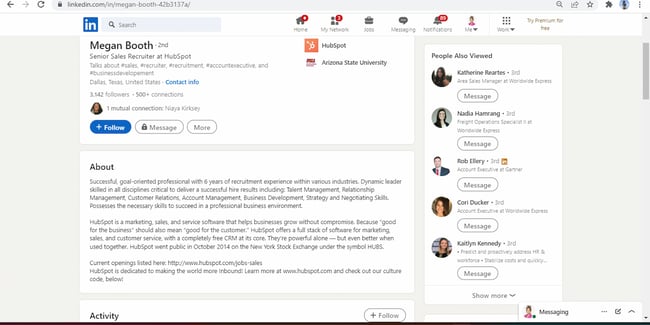Blogging has never been more important for businesses. Natalie Mootz lists six reasons for this:
- As much as ninety percent of organic search traffic to a business website can come through its blog.
- Fifty-two percent of B2B businesses say that blogs are the most important part of their content marketing success — beating out email, social media, and even in-person events.
- Blogging is the most cost-effective way to reach a niche audience.
- Blogs instill trust in with regular readers, which can lead to warmer leads.
- Blogging enhances your personal authority by giving you a long-form platform to share your thoughts vs. the shorter constraints of social media sharing (e.g. Twitter).
- Entrepreneurs can build their customer database by sharing how they work and what inspires them.
However, getting people to read those amazing blogs you write can be quite difficult. One way to fix this is to come up with killer blog post headlines. As Marko Saric says, there is an art to writing post headlines and bloggers have to master this art in order to attract more visitors.
Fortunately, this ultimate guide will help you master this art quickly! First, you will find out why the headline is the most important part of a blog. Then, you will find a list of fifty-two tips, tricks, hacks, and tools to come up with killer blog post headlines. Finally, you will discover thirty-four proven headline formulas that you can use. Are you ready?

The headline is the most important part of a blog post
Saric emphasizes that the headline is the most important part of a blog post because the majority of people that see your posts will see the headlines only. Without a compelling headline, not many will actually click to visit your blog post. After all, your potential visitors are busy people and you are competing to get their attention and a share of their valuable time. Therefore, to attract visitors, shares, and engagement, you must write powerful, relevant, and eye-catching headlines for your blog posts.
52 tips, tricks, hacks, and tools to write killer headlines
The following fifty-two tips, tricks, hacks, and tools come from Saric and from Kelly Smith, who works at CoSchedule, which is my favorite tool for analyzing headlines.
1. Use CoSchedule’s Headline Analyzer
As I mentioned above, this is my favorite tool for analyzing headlines, so this should be the first tip of this long list. I have been using it for years now (no, they have not paid me to say that). You type in a few different headline options, the Headline Analyzer will list them for easy comparison purposes, and you scroll down to find your Score and Word Balance. Pick the best one!
2. Write at least twenty-five headlines for every piece of content.
Because a blog post headline is so important, it is also important to spend time getting them right. Upworthy suggests writing twenty-five headlines per blog post. That might sound like a lot but you should consider this the bare minimum. Some will be better than others and some will be downright terrible.
I actually wrote twenty-five headlines for this blog post, eventually coming up with this one, which scored seventy-five in CoSchedule’s headline analyzer. The remark about the terrible ones is correct too, I even came up with two that scored forty-eight  Just keep going until you have the perfect one.
Just keep going until you have the perfect one.
3. Aim for Headline Analyzer scores of seventy or higher
Anything lower needs improvement. Holding yourself to this standard will ensure you write more effective headlines. So, the score of seventy-five is adequate.
4. Look for inspiration
Newspapers, magazines, and websites can be great idea sources, full of inspiration and ideas for your own headline writing. Keep an eye on them, explore them, learn from them, note interesting styles and formulas, and try and implement them on your own site.
5. Focus your headlines on helping instead of telling
Have a look at the most popular Google searches; they are mostly about solving a problem in the easiest and fastest way.
6. Suggest the best way to do something
Following the tip above, successful headlines connect with common searches and address a real target audience looking for the most effective strategies for solving their problem. Content starting with “The best way to…” has the potential to go viral super quickly.
7. Give advice for improvement
Instead of persuading your readers to do something, show them why it is worth the time to do it. Addressing the reasons and motivations of your readers serves as the basis for a really powerful message.
8. Provide solid evidence to support a claim
Nothing is more powerful than the “backed by science” claim. Insights derived from research are considered more accurate, relevant, and attractive.
9. Share your experience
“What I learned” is another great headline strategy. Speaking to your readers from experience, you gain their trust and you promise a solution that really works.
10. Avoid clickbait
The era of clickbait supremacy is over. If your headline over-promises and under-delivers, readers will leave disappointed.
11. Ensure your headline aligns with your content
Your headline should accurately reflect the angle of your content. Ask yourself what the point is of the piece of content you are writing and what the most important point is that this piece of content makes. If your headline does not address both of these points, it is time to start over.
12. Include numbers in list headlines
Writing a list? Say how many items this list includes right away. This gives readers a clear idea of what to expect.
13. Experiment with open- and closed-ended questions
Open-ended questions are great for encouraging discussion. Closed-ended questions, meanwhile, are effective for inspiring curiosity. Test each to see what performs best for you.
14. Hint at something interesting
Leave out just enough detail to get readers interested (without falling into the clickbait trap).
15. State a problem (and offer a solution)
It can be tough to stoke a problem and offer a solution in one headline. However, when done well, this technique can offer a solid emotional one-two punch.
16. Promise a solution to a problem
This one is a little different. Use ‘that will,’ ‘to,’ and ‘so’ in your headlines. This kind of headline already promises a certain value to be taken from reading the content.
17. Include a stat
People love to see numbers in headlines, especially when they seem difficult to believe. Therefore, if you have a powerful stat in your content, put it in your headline.
18. Know your audience
Make sure you know who your real audience is, and understand what their interests are. Google Analytics can help.
19. Speak like your audience
Use words and language your audience uses, such as jargon and technical terminology. You can get a sense of how your audience talks and what words they use simply by participating in social media conversations with them.
20. Be relevant and topical
Craft headline copy that targets relevant topics and discussions happening in your industry or niche.
21. Use positive superlatives for a strong, emotional headline
Positive superlatives that will help you in headline writing are best, always, fastest, easiest, most, greatest, largest, funniest, hottest, strongest, biggest, ever, perfect, and top.
22. Try negative superlatives to draw on fear and doubt
A study by Outbrain showed that headlines featuring negative superlatives performed thirty percent better than those with positive superlatives. Examples are never, worst, nothing, no one, no way, by no means, none. Featuring words like stop, avoid, or don’t in your headline is a good idea, too.
23. Use trigger words
In addition to the superlatives mentioned, you can use other words that trigger people to click on your blog post after reading the headline. Examples are Amazing, Avenge, Banned, Blissful, Boost, Breathtaking, Conspiracy, Controversial, Cure, Delightful, Discover, Empower, Energize, Exposed, Eye-Opening, Forbidden, Insider, Jaw dropping, Jubilant, Magic, Massive, Mind blowing, Overcome, Payback, Provocative, Reclaim, Skyrocketing, Spectacular, Stunning, Surprising, and Uncensored.
24. Front-load your headline structure
Make sure that your superlative is always at the front of your headline. For instance, “7 Worst Mistakes of Young Startups” sounds much better than “7 Mistakes Made by Young Startups That Are Worst.”
25. Be careful with humor
Avoid puns or jokes because your headline must be understandable outside of its context.
26. Invoke urgency
Is your content time-sensitive? Use words that inspire urgency. For example, if you are writing about an upcoming event with a registration deadline, make sure to urge the readers to register before the time runs out in your headline.
27. Make the unbelievable a reality
If your content includes something strange but true, use that to your advantage. If your content is good enough, your headline will sell the story without resorting to cheap clickbait tactics.
28. Understand the media types where you will use your headline
The length of your headline depends on what you want to do with it; different lengths work for different media like emails, social networks, search engines, and language engagement.
29. Avoid ambiguity and get to the point
If you want to follow the traditional strategy, write headlines that are information and keyword-rich, match the expectations of your target audience, and are understandable even when taken out of context. This also means keeping them relatively brief (if possible).
30. Know the best length for your language
Headline rules are not the same for every language and culture. What works for an English language blog in the United States will not work for a Spanish language blog in Spain. According to Outbrain, if you want your headline to perform well, consider the following for English: it should be between 60–100 characters and 16–18 words long.
31. Align your headlines for the biggest impact
Centered headlines are most powerful visually. Left-centered are more conservative and formal. Avoid justifying headline type as it can lead to bad lettering.
32. Write for search engines to help your readers find your content
Search engines will favor headlines that are shorter than seventy characters (which is relevant if your title tag is the same as your headline). Make sure your headline includes your target keyword as well.
33. Find words your readers are looking for with Google’s Keyword Planner
Use Google Keyword Planner to understand the search terms your target audiences look for. Google’s official support documentation explains how to use it.
34. Try using a suggested search term in your headline
Just type the first words of your headline to see whether the auto-fill suggestions are similar to it.
35. Look for related search terms
This list appears at the bottom of your search page and shows you what terms are related to the one you typed. That feature helps people shake up their searches to find relevant and related information.
36. Narrow your search results
Google Advanced Search will help you to narrow down your search results to see trends for a given region, language, and time frame.
37. Use “you” to address your readers
Address your reader as you. This simply grabs your readers’ attention and helps them relate the headline to their personal experience.
38. Help your readers see a better future for themselves
A headline like “How To Do ___ That Will Help You ___” clearly states the purpose of the content and boosts its accuracy in tackling one specific action or problem.
39. Keep it simple
Readers skim on the web, so use simple headlines with clear language to hook their attention fast. Overly complex headlines may get passed over.
40. Keep in mind, though, that simple does not have to mean generic
Generic headlines get buried and forgotten. Write until you score a winner of a headline.
41. Be specific
Narrowly focus on the one topic your content is about. Consider the main point and benefit of your post, and get granular by telling your readers exactly what your content contains.
42. Avoid passive voice
Use active instead of passive voice because active is easier to understand when scanning for interesting headlines.
43. Include words that reference additional content
If your blog post includes an infographic, guide, template, or other downloadable content, reference it in your headline. This gives readers added incentive to click, and provides more detail about the content your blog post includes.
44. Differentiate your headlines from the competition
Research what your competitors are doing. Identify the expressions, keywords, and phrases your competitors use in their content. From there, you will understand how to make your headlines stand out.
45. Publish headlines that brand your content
Make it easy for searchers to identify key differences between your content and the stuff other people publish. If you feel like your headlines sound exactly what a competitor may publish, write twenty-five more headlines and choose one with the most unique angle. Imagine the possibilities if a reader could read your headline and know it is your content just by its tone. That is the goal you should aim for.
46. Try headline ideas you have not experimented with before
Be creative! Do not be afraid of testing new content on your audience.
47. Use social media for simple A/B testing
Twitter makes quick and easy A/B testing easy. Simply try writing two different headlines, and use them as tweets to promote your content. Then, see which performs best. Over time, you will develop a clear picture of what clicks with your audience.
48. Contradict common wisdom
Is there a commonly accepted “truth” you want to challenge? Write a headline that clearly contradicts it. These types of headlines can generate a lot of attention but make sure you have data and evidence to support your counter-claim.
49. Recycle your old ideas with new headlines and angles
Recycle your content. A great evergreen piece of content can be easily recycled under a different headline based on thorough research meant to broaden the gap between you and your competition.
50. Consider every platform where your headline may appear
It is likely your content will be shared on social media. It will probably be in your email newsletter too. Try to write headlines that can easily be adjusted for multiple formats, such as social media posts and email subject lines.
51. Try alternative headlines for social media
What works well for a blog post might not work as well on social media. Consider writing alternative headlines to promote blog posts across various social channels. This can also be an easy way to test different types of messaging to see what resonates most with your audience.
52. Condense headlines for email
Headlines that perform well in emails are usually around fifty characters long and feature the strongest words at their beginning.
34 Proven headline formulas you should try on your site
Most winning headlines can be distilled down to a fill-in-the-blank formula template, which Saric has conveniently listed for us. These templates can then be used for any topic that you are covering:
- How To ___________ – Step-By-Step Guide
- The Ultimate ___________ List
- How To ___________ In 10 Minutes
- The Pros And Cons Of ___________
- The Easiest Way To Make Your ___________
- 12 Surefire Ways To ___________
- 8 Shortcuts For ___________ In Record Time
- Get ___________! 12 Ideas That Really Work
- The Lazy ___________ Way To ___________
- 16 Lies ___________ Like To Tell
- 13 Warning Signs That ___________
- The Shocking Truth About ___________
- 10 Things Your ___________ Won’t Tell You
- How Safe Is Your ___________ From ___________?
- Do You Do Any Of These ___________ Mistakes?
- Don’t Do These 17 Things When ___________
- 16 ___________ Mistakes You Don’t Know You’re Making
- 11 ___________ Mistakes That Make You Look ___________
- 15 Things Your ___________ Needs To Hear You Say
- Unlock The Secrets Of ___________
- 7 ___________ Secrets Every ___________ Should Know
- The 16 Essentials Of ___________
- How To Take Charge Of Your ___________
- How To Make ___________ Work For You
- What ___________ Can Teach You About ___________
- Can You Really Trust ___________?
- 5 Little Known Ways To ___________
- 3 Little Known Factors That Could Affect Your ___________
- Get Rid Of ___________ Once And For All
- 12 Cool Tools For ___________
- The Complete Guide To ___________
- 18 Tips To Jump-Start Your ___________
- 14 Things I‘ve Learned About ___________
- 18 ___________ Hacks: A Cheat Sheet For ___________
Evergreen blogs
I hope this guide helps you improve your blog post headlines and that you increase traffic as a result. Content creation is hard and a consistently high quality of content is even harder. One solution to this content problem is evergreen content, which was mentioned in this blog as well. The core topic of evergreen content will be relevant to readers no matter what is going on in the current news cycle or which season it is.





 The growth of Twitter monthly active users (
The growth of Twitter monthly active users ( A picture can often convey a message that people might otherwise miss in text.
A picture can often convey a message that people might otherwise miss in text. Creating a hashtag to identify with a brand can be a powerful tool
Creating a hashtag to identify with a brand can be a powerful tool Think hashtags through to avoid dangerous pitfalls
Think hashtags through to avoid dangerous pitfalls By following trends, you may be able to capitalise on them and push your brand or product further
By following trends, you may be able to capitalise on them and push your brand or product further



 Jared Spool at
Jared Spool at  David Skok,
David Skok, 

 Peter Fader,
Peter Fader, 
 Which Amazon Echo is right for you? The new Echo 2, Plus, Spot, Connect and Buttons, or the existing Dot, Show or Look? This handy chart lets you compare the functionality and pricing of Amazon’s entire Echo line that got several new additions today at a big launch event.
Though Amazon has traded simplicity for flexibility, the Amazon Echo sh*tshow makes Google Home look like…
Which Amazon Echo is right for you? The new Echo 2, Plus, Spot, Connect and Buttons, or the existing Dot, Show or Look? This handy chart lets you compare the functionality and pricing of Amazon’s entire Echo line that got several new additions today at a big launch event.
Though Amazon has traded simplicity for flexibility, the Amazon Echo sh*tshow makes Google Home look like… 







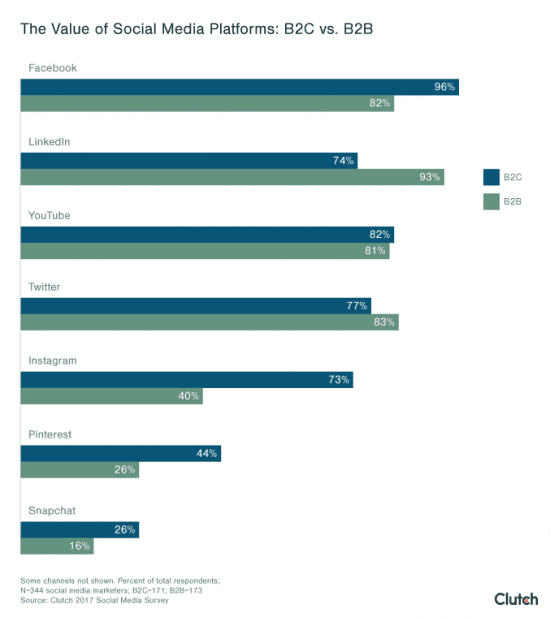

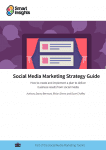















![→ Download Now: 80 Professional Bio Examples [Free Templates]](https://no-cache.hubspot.com/cta/default/53/4eb63650-d315-42e5-9ac7-8d0fcba29324.png)

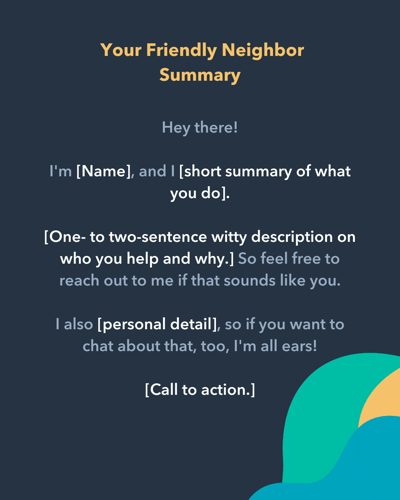
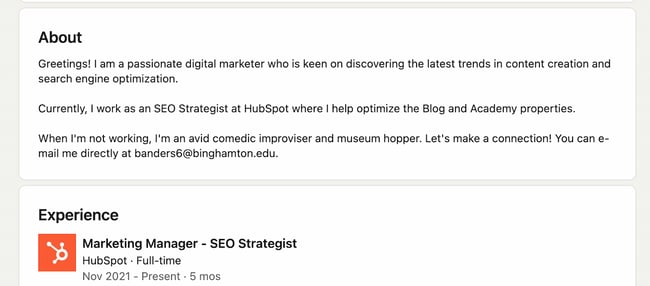
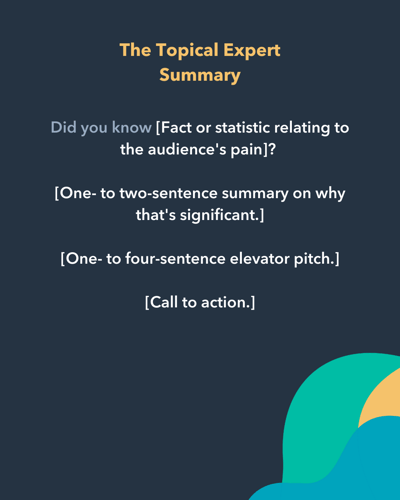
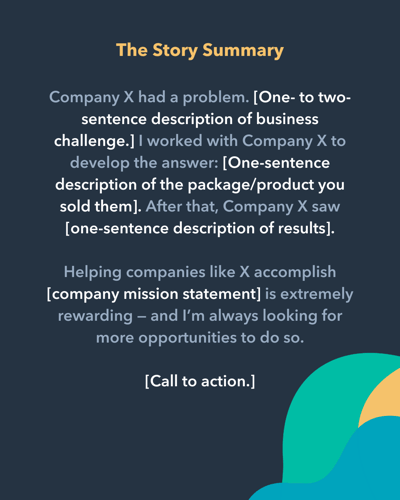
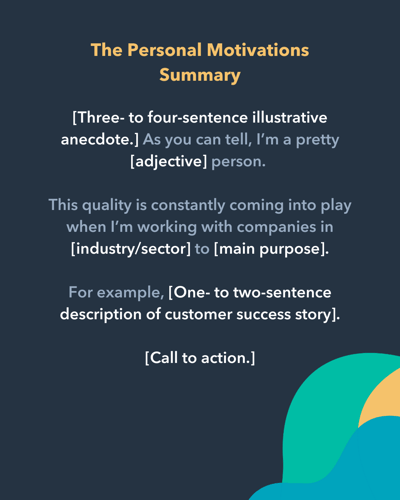
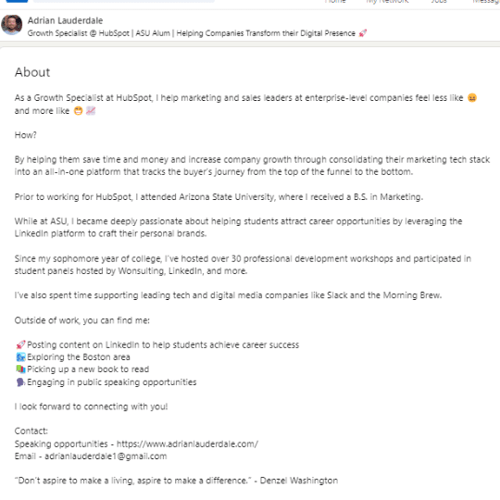
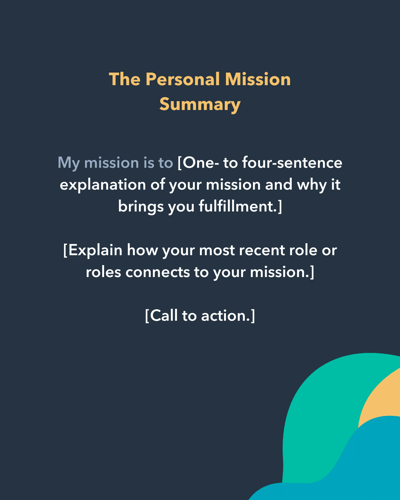 Similar to the personal motivations summary, this one relies on what drives you, with the goal of showing them who you are and what makes you tick. However, instead of personal attributes, you would start with the bigger picture: your mission, your vision, why you do what you do. This is particularly helpful to provide context to your motivations, especially if you have a varied background where your role didn't matter as much as the initiatives you supported.
Similar to the personal motivations summary, this one relies on what drives you, with the goal of showing them who you are and what makes you tick. However, instead of personal attributes, you would start with the bigger picture: your mission, your vision, why you do what you do. This is particularly helpful to provide context to your motivations, especially if you have a varied background where your role didn't matter as much as the initiatives you supported.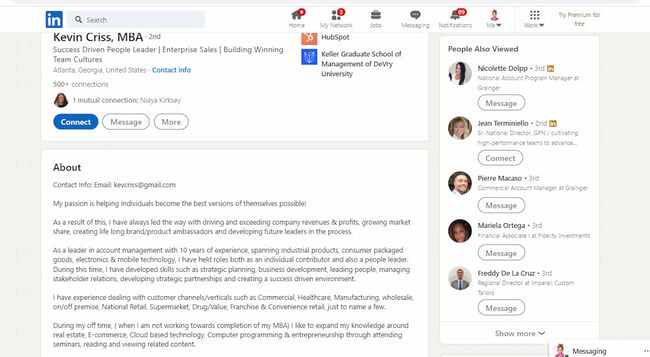
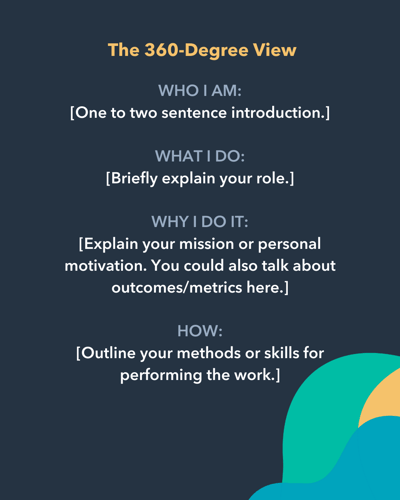 A common format for essay-writing, project management, and LinkedIn summaries is the 5Ws and an H: Who, What, When, Where, Why, How.
A common format for essay-writing, project management, and LinkedIn summaries is the 5Ws and an H: Who, What, When, Where, Why, How.
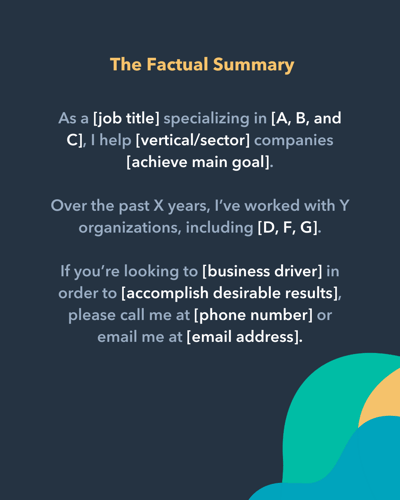 Are your prospective buyers in a traditional sector, such as medicine, banking, academia, government, or law? If so, a clear, concise, factual summary is your best bet. Prospects will be used to formal, conservative language — so a creative or offbeat summary might suggest you’re not familiar with their industry and its norms.
Are your prospective buyers in a traditional sector, such as medicine, banking, academia, government, or law? If so, a clear, concise, factual summary is your best bet. Prospects will be used to formal, conservative language — so a creative or offbeat summary might suggest you’re not familiar with their industry and its norms.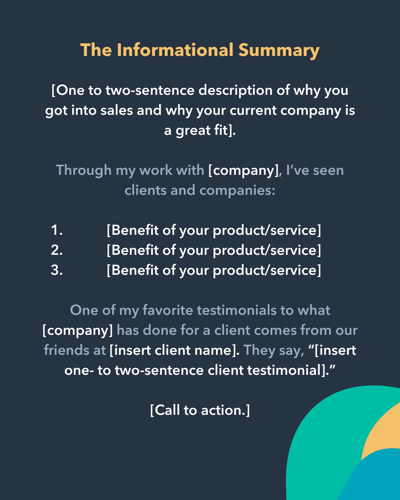 Want to start educating your prospect on the benefits of your product/service from the moment they click your profile? Try this approach.
Want to start educating your prospect on the benefits of your product/service from the moment they click your profile? Try this approach. Do you have a proven track record of success? Your LinkedIn summary can be a great place to share what you’ve accomplished. Recount a time you blew quota out of the water or negotiated a sale that helped your customer save time and money in the long run. Specify your successes and share your quantifiable wins along with how they helped your customer.
Do you have a proven track record of success? Your LinkedIn summary can be a great place to share what you’ve accomplished. Recount a time you blew quota out of the water or negotiated a sale that helped your customer save time and money in the long run. Specify your successes and share your quantifiable wins along with how they helped your customer.
 Leverage the benefits of search engine optimization (SEO) by including keywords your prospects are likely to be searching for in your summary. When you optimize your LinkedIn profile, use industry words your prospects are using in your search. That way, your profile is more likely to come up in search queries, potentially putting you in front of a wider audience of viable prospects.
Leverage the benefits of search engine optimization (SEO) by including keywords your prospects are likely to be searching for in your summary. When you optimize your LinkedIn profile, use industry words your prospects are using in your search. That way, your profile is more likely to come up in search queries, potentially putting you in front of a wider audience of viable prospects.